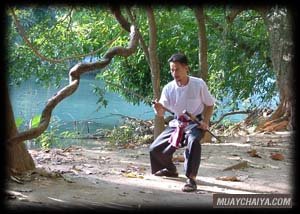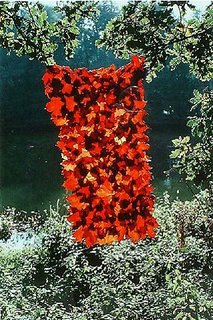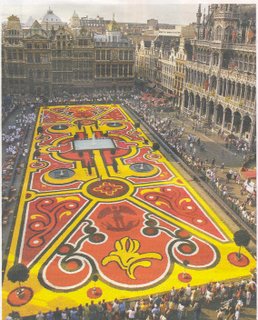
Thai national martial art is, naturally, MuayThai. But how many really know the true Muay Thai beyond the thought of two big, muscular boxers furiously exchanging kicks as seen at the boxing camps or the famous stadiums such as the Lumpinee and the Rachadumneun?
The original Muay Thai uses one’s wits more than brute strength, and ends up with injury sustained by both sides. Muay Chaiya, a style of Muay Thai, has clearly illustrates this fact.
Muay Thai Chaiya, or as called by it’s full name as Pahuyuth Muay Thai Chaiya, translated to be the way of Thai fighting, hand to hand combat, Chaiya style, can hardly be seen now a days. But there is a place where Muay Chaiya is taught to interested public, so the heritage of the old and traditional Muay Thai, or Muay Boran, can be passed down. This is to keep alive a true Thai tradition, which most people have only seen in books or movies.
Master Amornkrit Pramuan, or Kru Preang to his Muay Thai students, has carried on the intention of the masters, who had come before him, to continue the legacy of preserving Muay Thai in it’s true form, which had been forgotten since the banning of fighting with rope, or hem binding as we called Muay Kad-Chuek. Many techniques, unique to Muay Thai, have been lost due to the imposing of rules adapted from western boxing.
Kru (teacher) Preang, was the close student of Kru Thong Chuer-Chaiya, who had inherited the Muay Thai Chaiya from the Grand Master Ketr Sriyapai (the last grand master of Muay Thai), who had learned from his father, Phraya Wajeesatayarak, the provincial governor of Chaiya. The Grand Master also learned from another 13 masters until he was well versed in MuayThai.
Muay Thai Chaiya, not only utilizes fists, feet, knees, and elbows as we commonly see in the main stream Muay Thai, but also uses the forgotten elements of throwing, pressing, grabbling or clinching and joint breaking (Toom-Tup-Jub-Huk), they are no less dangerous than the throwing and joint locking of other martial arts. There are other sets of techniques with names that rhyme and contain deep meanings. They are to lure, to mislead, to elude, to avoid, to deceive, and to tease (Lor-Lork-Lop-Leek-Lorklor-Lorlen), or to hug, to squeeze, to swing the opponent from side to side, and to cast or throw the opponent down (Kod-Rad-Fad-Wieng). These are the techniques for inside fighting, that we no longer see in today’s Muay Thai. Even the way to fall, to get up, to roll on the ground, and to crawl (Lom-Look-Klook-Klan), which deal with proper way of rolling on the ground and falling so the practitioners wouldn’t get hurt.
So, an exponent of the old and traditional Muay Thai, such as Muay Thai Chaiya, does not limit oneself to only one-dimensional fighting of stand up strike. If the fight takes one down to the ground, one still has to be able to fight effectively. Since the old traditional Muay Thai was created for the engagement in battlefields, being able to engage with several opponents at the same time has made Muay Thai Chaiya so formidable.
Classes are conducted in the old traditional and systematic way. Students will learn from basic. They will learn how to defend themselves by blocking or shielding, brushing away, covering, and opening (Pong-Pud-Pid-Perd), until one is proficient and confident enough to protect oneself from being attacked. Then one will gradually learn other extended Muay Thai techniques, or Look-mai. This is different from the main stream Muay Thai, where the boxer will train to take offensive posture of solely kicking, punching and to destroy one’s opponent, and in return, by depending on the physical toughness of oneself, to receive kicks and punches from the opponent. As the teachers, or “Kru’ of Muay Thai Chaiya have strongly affirmed that an exponent of an art of self defend has to be able to actually defend oneself from harm. One should not achieve winning status because of one’s durability.
Corrections and changes were made through the wisdom of past Muay Thai teachers, Muay Thai is devastating with numerous trick techniques, extended techniques, and principal techniques. These said techniques can branch out, virtually, without limit. The learning of this devastating art of fighting, develops oneself to be a person with patient, strong determination, and yet, serene. All in all, to learn the way of fighting, will develop an exponent to be a good member of the society, who is always consciously alert, well behave, just as one who has been taught by a teacher.
Kru Preang has also drawn a curriculum for weaponry that co-exists with Muay Thai Chaiya. It is commonly known as Krabi-Krabong, or “sword and staff” which actually means the use of short and long weapons. They consist of two-hand swords, knife, long pole or staff, short staff, or elbow staff (mai-sork), as well as, all other old traditional Thai weapons, that one can not easily find a place to learn. This is a true combination of all the traditional Thai martial arts.
Muay Thai Chaiya and Thai Weaponry Conservation Foundation
Kru Preang (Amornkrit Pramuan)Muay Thai Chaiya and Thai Weaponry FoundationOffers Classes on the Chaiya Style of Muay Boran (the old traditional Muay Thai), Muay Kad-Chuek (the hemp bound fist fighting), Thai sword fight, and all other traditional weapons.







